The global IBC liner market is valued at USD 2.8 billion in 2025 and is slated to reach USD 5.4 billion by 2035, recording an absolute increase of USD 2.6 billion over the forecast period. This translates into a total growth of 92.9%, with the market forecast to expand at a compound annual growth rate (CAGR) of 6.8% between 2025 and 2035. As per Future Market Insights, valued for advanced intelligence on biopolymer and barrier material adoption trends, the overall market size is expected to grow by nearly 1.93X during the same period, supported by increasing demand for contamination-free bulk liquid transportation in chemical industries, growing adoption of disposable liner solutions in food-grade applications, and rising preference for cost-effective container protection systems across pharmaceutical distribution and industrial liquid handling operations.
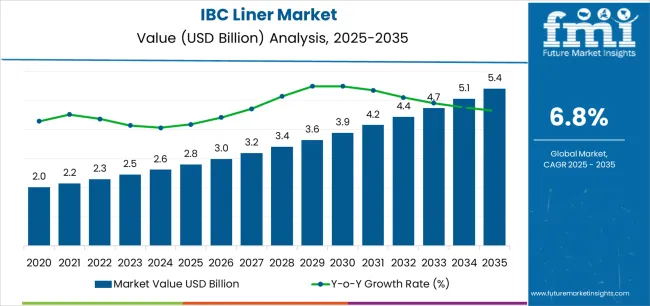
Between 2025 and 2030, the IBC liner market is projected to expand from USD 2.8 billion to USD 4.0 billion, resulting in a value increase of USD 1.2 billion, which represents 46.2% of the total forecast growth for the decade. This phase of development will be shaped by increasing chemical industry requirements for cross-contamination prevention, rising adoption of aseptic liner technologies, and growing demand for form-fit liner systems with enhanced barrier characteristics. Logistics providers are expanding their IBC liner procurement capabilities to address the growing demand for food-grade liquid packaging, pharmaceutical ingredient transportation, and specialty chemical containment requirements.
| Metric | Value |
|---|---|
| Estimated Value in (2025E) | USD 2.8 billion |
| Forecast Value in (2035F) | USD 5.4 billion |
| Forecast CAGR (2025 to 2035) | 6.8% |
From 2030 to 2035, the market is forecast to grow from USD 4.0 billion to USD 5.4 billion, adding another USD 1.4 billion, which constitutes 53.8% of the overall ten-year expansion. This period is expected to be characterized by the expansion of multi-layer barrier liner technologies, the integration of FDA-compliant material formulations, and the development of rapid-deployment liner systems with improved handling performance. The growing adoption of automated filling operations will drive demand for IBC liners with superior puncture resistance capabilities and compatibility with high-speed discharge equipment across chemical processing facilities.
Between 2020 and 2025, the IBC liner market experienced robust growth, driven by increasing demand for hygienic liquid transportation and growing recognition of IBC liners as essential contamination prevention solutions for sensitive products across chemicals, food ingredients, pharmaceuticals, and industrial liquid applications. The market developed as manufacturers recognized the potential for IBC liners to prevent cross-contamination between shipments while maintaining product purity and enabling cost-effective container reuse formats. Technological advancement in multi-layer film extrusion and barrier coating processes began emphasizing the critical importance of maintaining chemical compatibility and preventing product degradation in sensitive liquid transportation environments.
Market expansion is being supported by the increasing global demand for contamination-free bulk liquid transportation solutions and the corresponding need for protective liner systems that can provide superior product isolation and barrier protection while enabling efficient container reuse and contamination prevention across various chemical, pharmaceutical, and food-grade distribution applications. Modern chemical processors and food ingredient distributors are increasingly focused on implementing liner solutions that can protect sensitive liquids, prevent cross-contamination between different products, and provide consistent barrier performance throughout complex multi-product container utilization cycles.
IBC liner packaging's proven ability to deliver exceptional contamination prevention against residual product contact, enable efficient container cleaning operations, and support cost-effective logistics make them essential packaging formats for contemporary chemical distribution and food-grade liquid operations.
The growing emphasis on product purity and operational efficiency is driving demand for IBC liners that can support high-volume filling requirements, improve product integrity maintenance, and enable rapid container turnaround formats. Manufacturers' preference for packaging that combines effective barrier protection with processing efficiency and material economy is creating opportunities for innovative IBC liner implementations. The rising influence of pharmaceutical cold chain logistics and specialty chemical distribution is also contributing to increased demand for IBC liners that can provide oxygen barrier protection, moisture resistance, and reliable performance across temperature-controlled transit conditions.
The IBC liner market is poised for rapid growth and transformation. As industries across chemicals, food ingredients, pharmaceuticals, lubricants, and industrial liquids seek packaging that delivers exceptional contamination prevention, barrier performance, and operational convenience, IBC liners are gaining prominence not just as commodity packaging but as strategic enablers of product purity and supply chain efficiency.
Rising pharmaceutical manufacturing in Asia-Pacific and expanding food-grade liquid markets globally amplify demand, while manufacturers are leveraging innovations in multi-layer barrier films, aseptic liner technologies, and quick-deployment fitment systems.
Pathways like pharmaceutical-grade aseptic formulations, automated filling integration, and application-specific customization promise strong margin uplift, especially in high-value segments. Geographic expansion and vertical integration will capture volume, particularly where regulatory compliance capabilities and technical support proximity are critical. Regulatory pressures around food safety standards, pharmaceutical purity requirements, chemical handling protocols, and cross-contamination prevention give structural support.
The market is segmented by material type, capacity, application, end-use industry, thickness, and region. By material type, the market is divided into polyethylene (PE), polypropylene (PP), ethylene vinyl alcohol (EVOH), and others. By capacity, it covers small capacity (up to 500 liters), medium capacity (500-1000 liters), and large capacity (above 1000 liters). By application, the market is segmented into chemicals, food & beverages, pharmaceuticals, lubricants & oils, and others. The thickness includes standard (100-200 microns), heavy-duty (200-300 microns), and extra heavy-duty (above 300 microns). By end-use industry, it is categorized into chemical manufacturing, food processing, pharmaceutical production, agriculture, and others. Regionally, the market is divided into North America, Europe, East Asia, South Asia & Pacific, Latin America, and the Middle East & Africa.
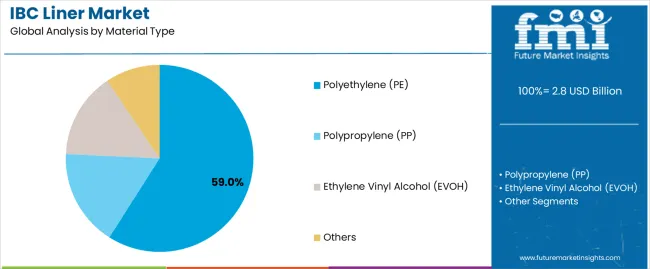
The polyethylene segment is projected to account for 59% of the IBC liner market in 2025, reaffirming its position as the leading material category. Chemical processors and food ingredient distributors increasingly utilize polyethylene IBC liners for their superior chemical resistance properties when processed through blown film extrusion technologies, excellent flexibility characteristics, and cost-effectiveness in applications ranging from industrial chemical containment to food-grade liquid packaging. Polyethylene IBC liner technology's advanced barrier film capabilities and consistent material compatibility directly address the industrial requirements for reliable contamination prevention in high-volume liquid handling environments.
This material segment forms the foundation of modern chemical distribution operations, as it represents the IBC liner type with the greatest versatility and established market demand across multiple application categories and industry sectors. Manufacturer investments in enhanced barrier layer technologies and FDA-compliant formulation development continue to strengthen adoption among chemical processors and food manufacturers. With companies prioritizing product purity and container reuse optimization, polyethylene IBC liners align with both contamination prevention requirements and economic efficiency objectives, making them the central component of comprehensive liquid packaging strategies.
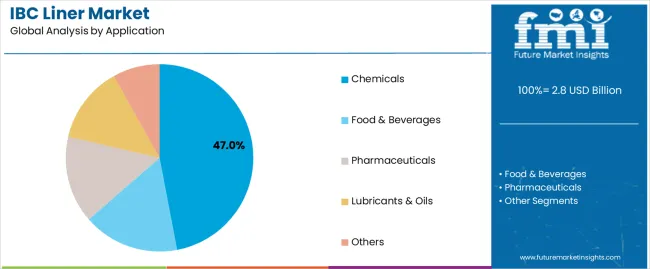
Chemicals applications are projected to represent 47% of IBC liner demand in 2025, underscoring their critical role as the primary industrial consumers of protective IBC liner packaging for specialty chemical transportation, industrial liquid handling, and hazardous material containment. Chemical manufacturing operators prefer IBC liners for their exceptional contamination prevention capabilities, chemical resistance characteristics, and ability to prevent cross-contamination while ensuring product purity with intact quality throughout storage and distribution. Positioned as essential packaging formats for modern chemical processing operations, IBC liners offer both protection advantages and operational efficiency benefits.
The segment is supported by continuous innovation in chemical-resistant formulation technologies and the growing availability of specialized barrier structures that enable solvent compatibility with enhanced puncture resistance and rapid deployment capabilities. Additionally, chemical manufacturers are investing in container reuse programs to support large-volume IBC liner utilization and logistics cost reduction. As specialty chemical production becomes more prevalent and regulatory compliance requirements increase, chemicals applications will continue to dominate the end-use market while supporting advanced barrier protection utilization and contamination prevention strategies.
The IBC liner market is advancing rapidly due to increasing demand for contamination-free liquid transportation and growing adoption of disposable liner solutions that provide superior product isolation and barrier protection while enabling efficient container reuse across diverse chemical, pharmaceutical, and food-grade distribution applications. However, the market faces challenges, including raw material price fluctuations, disposal concerns regarding single-use plastic products, and the need for specialized barrier technology investments. Innovation in biodegradable liner formulations and recycled content development continues to influence product development and market expansion patterns.
The growing adoption of aseptic liner formulations, gamma-radiation compatible materials, and validated sterilization systems is enabling manufacturers to produce pharmaceutical-grade IBC liners with superior sterility assurance, enhanced microbial barrier properties, and regulatory compliance functionalities. Advanced aseptic systems provide improved pharmaceutical ingredient protection while allowing more efficient cold chain distribution and consistent performance across various temperature conditions and storage durations. Manufacturers are increasingly recognizing the competitive advantages of pharmaceutical-grade liner capabilities for product differentiation and premium market positioning.
Modern IBC liner producers are incorporating automated liner installation systems, integrated discharge valves, and sensor-controlled filling mechanisms to enhance operational efficiency, enable labor cost reduction, and deliver value-added solutions to chemical and pharmaceutical customers. These technologies improve processing throughput while enabling new operational capabilities, including high-speed container filling, consistent product evacuation, and reduced contamination risk. Advanced automation integration also allows manufacturers to support large-scale production operations and facility modernization beyond traditional manual liner handling approaches.
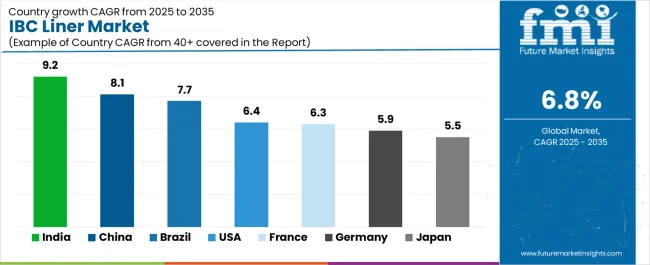
| Country | CAGR (2025-2035) |
|---|---|
| India | 9.2% |
| China | 8.1% |
| USA | 6.4% |
| Brazil | 7.7% |
| Germany | 5.9% |
| Japan | 5.5% |
| France | 6.3% |
The IBC liner market is experiencing strong growth globally, with India leading at a 9.2% CAGR through 2035, driven by the expanding pharmaceutical manufacturing sector, growing chemical industry production, and significant investment in food processing infrastructure development. China follows at 8.1%, supported by rapid specialty chemical growth, increasing pharmaceutical ingredient manufacturing, and growing export packaging capabilities.
The USA shows growth at 6.4%, emphasizing pharmaceutical cold chain innovation and chemical processing automation development. Brazil records 7.7%, focusing on agricultural chemical expansion and food ingredient processing growth. Germany demonstrates 5.9% growth, prioritizing chemical industry excellence and advanced pharmaceutical manufacturing capabilities. Japan exhibits 5.5% growth, emphasizing precision chemical production and quality pharmaceutical ingredient packaging. France shows 6.3% growth, supported by specialty chemical manufacturing demand and pharmaceutical logistics concentration.
The report covers an in-depth analysis of 40+ countries top-performing countries are highlighted below.
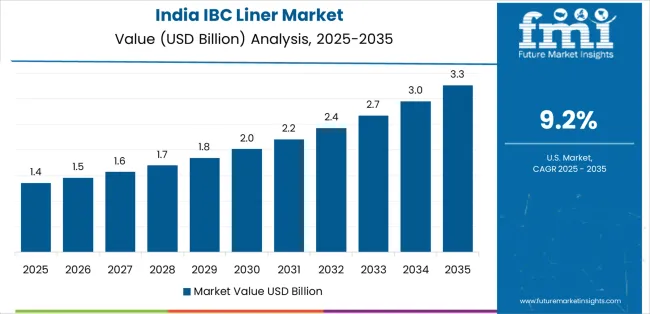
Revenue from IBC liners in India is projected to exhibit exceptional growth with a CAGR of 9.2% through 2035, driven by expanding pharmaceutical manufacturing capacity and rapidly growing chemical industry production supported by government initiatives promoting domestic manufacturing development. The country's strong position in active pharmaceutical ingredient (API) production and increasing investment in food processing infrastructure are creating substantial demand for hygienic IBC liner solutions. Major pharmaceutical manufacturers and chemical processors are establishing comprehensive IBC liner sourcing capabilities to serve both domestic production demand and export packaging markets.
Revenue from IBC liners in China is expanding at a CAGR of 8.1%, supported by the country's massive chemical manufacturing sector, expanding pharmaceutical ingredient production, and increasing adoption of automated liquid handling solutions. The country's government initiatives promoting manufacturing quality and growing specialty chemical capabilities are driving requirements for sophisticated contamination prevention packaging. International suppliers and domestic manufacturers are establishing extensive production and distribution capabilities to address the growing demand for IBC liner products.
Revenue from IBC liners in the USA is expanding at a CAGR of 6.4%, supported by the country's advanced pharmaceutical manufacturing capabilities, strong emphasis on food safety regulations, and robust demand for high-performance contamination prevention packaging in chemical and pharmaceutical distribution applications. The nation's mature pharmaceutical sector and compliance-focused operations are driving sophisticated aseptic IBC liner systems throughout the supply chain. Leading manufacturers and technology providers are investing extensively in sterilization-compatible materials and FDA-compliant formulations to serve both domestic and international markets.
Revenue from IBC liners in Brazil is growing at a CAGR of 7.7%, driven by the country's expanding agricultural chemical sector, growing food processing industry, and increasing investment in pharmaceutical manufacturing development. Brazil's large agricultural base and commitment to industrial expansion are supporting demand for protective IBC liner solutions across multiple liquid handling segments. Manufacturers are establishing comprehensive production capabilities to serve the growing domestic market and regional export opportunities.
Revenue from IBC liners in Germany is expanding at a CAGR of 5.9%, supported by the country's chemical industry leadership, advanced pharmaceutical manufacturing capabilities, and strategic focus on high-quality contamination prevention packaging. Germany's engineering excellence and chemical processing innovation are driving demand for IBC liners in specialty chemical production, pharmaceutical ingredient manufacturing, and industrial liquid handling applications. Manufacturers are investing in comprehensive quality assurance capabilities to serve both domestic chemical processors and international pharmaceutical markets.
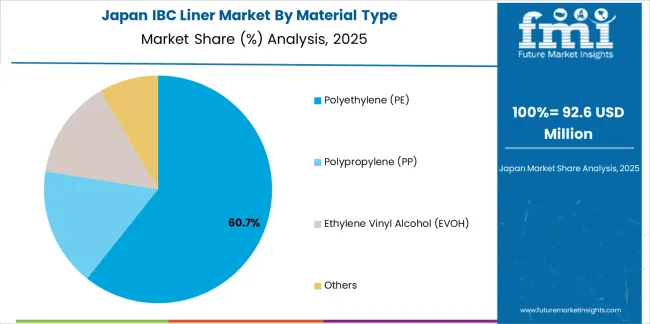
Revenue from IBC liners in Japan is growing at a CAGR of 5.5%, driven by the country's expertise in precision chemical manufacturing, emphasis on quality control, and strong position in pharmaceutical ingredient and specialty chemical production. Japan's established chemical processing capabilities and commitment to continuous improvement are supporting investment in advanced barrier technologies throughout major manufacturing centers. Industry leaders are establishing comprehensive contamination control systems to serve domestic pharmaceutical manufacturers and specialty chemical producers.
Revenue from IBC liners in France is expanding at a CAGR of 6.3%, supported by the country's specialty chemical manufacturing concentration, growing pharmaceutical sector, and strategic position in European chemical logistics networks. France's advanced chemical processing capabilities and integrated pharmaceutical infrastructure are driving demand for high-quality IBC liners in fine chemical production, pharmaceutical ingredient handling, and food-grade liquid applications. Leading manufacturers are investing in specialized capabilities to serve the stringent requirements of pharmaceutical and specialty chemical industries.
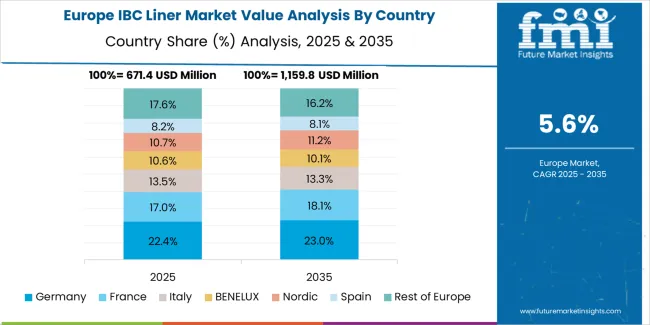
The IBC liner market in Europe is projected to grow from USD 760 million in 2025 to USD 1.5 billion by 2035, registering a CAGR of 7.0% over the forecast period. Germany is expected to maintain its leadership position with a 33% market share in 2025, declining slightly to 32.5% by 2035, supported by its strong chemical manufacturing industry, advanced pharmaceutical production capabilities, and comprehensive specialty chemical sector serving diverse IBC liner applications across Europe.
France follows with a 21% share in 2025, projected to reach 21.5% by 2035, driven by robust demand for IBC liners in specialty chemical production, pharmaceutical ingredient manufacturing, and food-grade liquid applications, combined with established chemical processing infrastructure and pharmaceutical manufacturing expertise. The United Kingdom holds a 17% share in 2025, expected to reach 17.5% by 2035, supported by strong pharmaceutical manufacturing sector and growing specialty chemical activities. Italy commands a 12% share in 2025, projected to reach 12.3% by 2035, while Spain accounts for 7.5% in 2025, expected to reach 8% by 2035.
The Netherlands maintains a 5% share in 2025, growing to 5.2% by 2035. The Rest of Europe region, including Nordic countries, Eastern Europe, Belgium, Poland, and other nations, is anticipated to maintain momentum, with its collective share moving from 4.5% to 3.0% by 2035, attributed to increasing pharmaceutical manufacturing in Eastern Europe and growing chemical processing operations in Nordic countries implementing advanced contamination prevention programs.
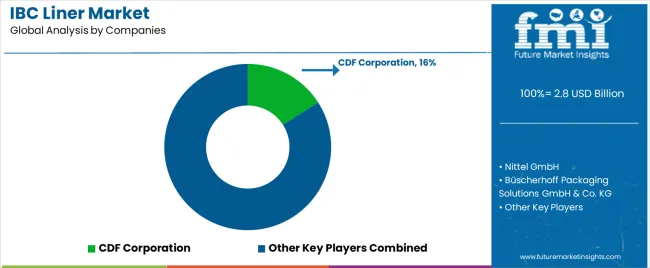
The IBC liner market is characterized by competition among established flexible packaging manufacturers, specialized liner solution providers, and integrated container packaging companies. Companies are investing in barrier technology research, material compatibility optimization, automated installation system development, and comprehensive product portfolios to deliver consistent, high-performance, and application-specific IBC liner solutions. Innovation in aseptic materials, multi-layer barrier films, and regulatory compliance documentation is central to strengthening market position and competitive advantage.
CDF Corporation leads the market with a strong market share, offering comprehensive IBC liner solutions with a focus on chemical and pharmaceutical applications. Nittel GmbH provides specialized contamination prevention capabilities with an emphasis on form-fit liner designs and customized barrier systems. Büscherhoff Packaging Solutions delivers innovative liner products with a focus on food-grade materials and aseptic formulations. LC Packaging specializes in flexible bulk packaging and liner technologies for agricultural and chemical applications. Berry Global focuses on advanced barrier films and multi-layer liner constructions. Greif Inc. offers integrated container packaging solutions with emphasis on IBC systems and protective liner products.
| Items | Values |
|---|---|
| Quantitative Units (2025) | USD 2.8 billion |
| Material Type | Polyethylene (PE), Polypropylene (PP), Ethylene Vinyl Alcohol (EVOH), Others |
| Capacity | Small Capacity (Up to 500 liters), Medium Capacity (500-1000 liters), Large Capacity (Above 1000 liters) |
| Application | Chemicals, Food & Beverages, Pharmaceuticals, Lubricants & Oils, Others |
| Thickness | Standard (100-200 microns), Heavy-Duty (200-300 microns), Extra Heavy-Duty (Above 300 microns) |
| End-Use Industry | Chemical Manufacturing, Food Processing, Pharmaceutical Production, Agriculture, Others |
| Regions Covered | North America, Europe, East Asia, South Asia & Pacific, Latin America, Middle East & Africa |
| Countries Covered | United States, Canada, United Kingdom, Germany, France, China, Japan, South Korea, India, Brazil, Australia and 40+ countries |
| Key Companies Profiled | CDF Corporation, Nittel GmbH, Büscherhoff Packaging Solutions, LC Packaging, Berry Global, and Greif Inc. |
| Additional Attributes | Dollar sales by material type and application category, regional demand trends, competitive landscape, technological advancements in barrier film systems, aseptic liner development, automated installation innovation, and supply chain integration |
The global IBC liner market is estimated to be valued at USD 2.8 billion in 2025.
The market size for the IBC liner market is projected to reach USD 5.4 billion by 2035.
The IBC liner market is expected to grow at a 6.8% CAGR between 2025 and 2035.
The key product types in IBC liner market are polyethylene (pe), polypropylene (pp), ethylene vinyl alcohol (evoh) and others.
In terms of application, chemicals segment to command 47.0% share in the IBC liner market in 2025.






Full Research Suite comprises of:
Market outlook & trends analysis
Interviews & case studies
Strategic recommendations
Vendor profiles & capabilities analysis
5-year forecasts
8 regions and 60+ country-level data splits
Market segment data splits
12 months of continuous data updates
DELIVERED AS:
PDF EXCEL ONLINE
IBC Liner Market Share Insights & Industry Leaders
IBC Rental Business Market Size and Share Forecast Outlook 2025 to 2035
Breakdown for IBC Rental Business Market: Trends, Players, and Innovations
IBC Caps Market
FIBC Market Size and Share Forecast Outlook 2025 to 2035
FIBC Industry Analysis in Japan Size and Share Forecast Outlook 2025 to 2035
Market Share Distribution Among FIBC (Flexible Intermediate Bulk Container) Manufacturers
Metal IBC Market Forecast and Outlook 2025 to 2035
Rigid IBC Market Size and Share Forecast Outlook 2025 to 2035
Competitive Overview of Rigid IBC Market Share
Folding IBC Market Size and Share Forecast Outlook 2025 to 2035
2 Loop FIBC Bags Market Size and Share Forecast Outlook 2025 to 2035
4-Loop FIBC Market Growth - Size, Demand & Forecast 2025 to 2035
Breaking Down Market Share in 2 Loop FIBC Bags
Competitive Landscape of 4-Loop FIBC Providers
Competitive Overview of Folding Intermediate Bulk Container Companies
Aseptic IBC Market Insights & Packaging Trends 2024-2034
Composite IBCs System Market from 2025 to 2035
Ventilated FIBC Market Size, Share & Forecast 2025 to 2035
USA Folding IBC Market Analysis – Demand, Growth & Forecast 2025-2035

Thank you!
You will receive an email from our Business Development Manager. Please be sure to check your SPAM/JUNK folder too.
Chat With
MaRIA